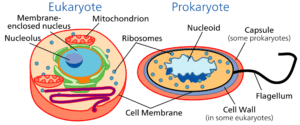

During infection of Pseudomonas bacteria with the phage 2O1phi2-1, a separate compartment forms in which viral DNA replication takes place. A phage protein, gp105, makes up the outer layer of this compartment, which initially forms near one end of the cell, and then migrates to the center. The migration of the compartment takes place on a spindle made up of the tubulin-like protein PhuZ.
In addition to viral DNA, certain proteins gain entry into this compartment, including viral proteins involved in DNA and mRNA synthesis, and at least one host cell protein. Other proteins, such as those involved in translation and nucleotide synthesis, are excluded. This compartmentalization very much resembles that of the nucleus of eukaryotic cells.
Packaging of the viral DNA takes place on the surface of the viral nucleus. Empty phage capsids form at the bacterial cytoplasmic membrane, then migrate to the compartment where they attach firmly to the surface. By an unknown mechanism, DNA moves from the compartment into the capsid. Then capsids are released from the surface to further mature in the cytoplasm. The completed phages are released from the cell upon bacterial lysis.
These fascinating observations raise a number of unanswered questions. Does infection with other phages lead to assembly of a viral nucleus? How do molecules selectively move in and out of the structure?
Perhaps the most interesting question relates to the origin of viruses and cells. According to one hypothesis, self-replicating, virus-like nucleic acids might have first appeared on Earth, followed by cells without a nucleus. Was the nucleus a viral invention?

This is amazing and it seems to give support to the viral eukaryogenesis hypothesis by Philip J. Bell, which you seem to hint at in your last paragraph. Are you familiar with it, Vincent?
More info on the hypothesis.
https://en.wikipedia.org/wiki/Viral_eukaryogenesis
http://onlinelibrary.wiley.com/doi/10.1111/j.1749-6632.2009.04994.x/full
Pingback: Prions in bacteria
Pingback: parasites | [Veterinary and Medical Sciences
Pingback: A viral nucleus – Virology